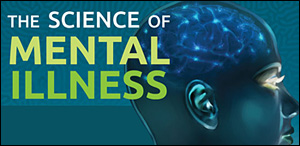With 50 million Americans suffering from some form of mental illness or disorder, it’s no wonder scientists and psychologists have spent so much time trying to better understand what causes many of these disorders.

The infographic below shows some interesting stats regarding mental illness:
- 1 in 4 adults have a mental illness
- 36% of adults with a mental disorder are receiving treatment
- 50% of the people with mental disorders have multiple disorders, such as Bipolar and OCD combined
- 18% are Anxiety disorders such as panic disorder
- Half of those, or 9.5% have Mood disorders like Depression
Aside from the statistics, it’s important to understand that chemical changes in the brain can contribute to overall mental health, and imbalances of too much or too little often decide how the disorder is expressed. For instance, too much of the neurotransmitter Dopamine can signify Schizophrenia, while not enough Dopamine can cause certain types of Depression.
Neurotransmitters balance brain chemistry and act as control centers for the brain. Too much or too little activity and the brain is chemically unbalanced. Drug or alcohol addiction can be key reasons for this imbalance in the brain. When addiction and a mental disorder are both present together, it is known as a dual diagnosis or co-occurring disorder and it requires specialized treatment.
How Do Neurotransmitters Balance Our Brain Chemistry?
Moving on to the body in general, each type of mental disorder can cause different physical characteristics that might be problematic. Anxiety disorders can cause weight changes, nausea, or a racing heart. Depression, on the other hand, can show symptoms of insomnia, headaches, or changes in appetite.
Only a doctor can accurately diagnose and treat mental disorders. Some require medications, at least for a short time, to restore the brain’s chemical health, while others respond well to varying forms of psychotherapy. Certain disorders respond very well to a combination of medication and psychotherapy.
Whatever the problem, it’s important to seek help. There’s no sense in living with a mental disorder when so much can be done to return a person to a healthy state of living. Fear is one of the biggest deterrents to seeking treatment for most people. Many fear not only being diagnosed with disorder, but also the shame they feel from being labeled crazy. It’s not crazy, and there’s no shame in treatment. When 50 million Americans share a similar problem, it’s no small minority.
To view this infographic in a larger size, visit Best Masters in Psychology.
Related:
June is Post-Traumatic Stress Disorder Awareness Month






